Back to Don's Maps
Back to Venus figures from the Stone Age
Gagarino Venus Figures
Gagarino is located on a loess terrace on the north lip of a ravine on the right bank of the Don River about five kilometres north of the junction of the Sosna, a tributary stream. It is north of the well known Kostienki sites. Here peasants discovered a house pit while excavating a silo trench. Unfortunately, the trench cut through the centre of the house pit along its major axis and presumably destroyed the hearth and entrance. Zamiatinine (1934) who excavated this site during 1926 - 1929, found a house pit roughly oval in outline about 5.5 metres long and 4.5 metres wide. The floor was located 40 to 60 cm below the occupational surface. The walls of the pit were lined with the long bones of rhinoceros and mammoth, including the tusks and lower jaws of the latter, as well as with sandstone slabs. The wealth of material remains found in this one house pit is seen in the recorded finds of some six hundred flint implements, over a thousand blades, and proportionately large numbers of cores and waste flints. Artefacts of bone as well as several 'venus' figurines completed the roster of non-lithic material. One date given for the site is 21 800 ± 300 BPText above: Daifuku (1952), White (2007)
The Gagarino Venus
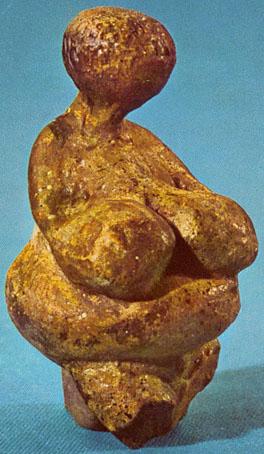
Figurine of an obese woman from Gagarino, Russia. Height 58 mm, 23 000 BP
Photo and text: J Jelinek, 'The Evolution of Man'
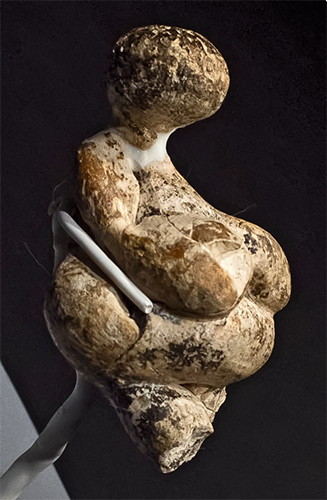
The Gagarino venus from the right side.
Photo: Thilo Parg / Wikimedia Commons
Permission: Lizenz: CC BY-SA 4.0
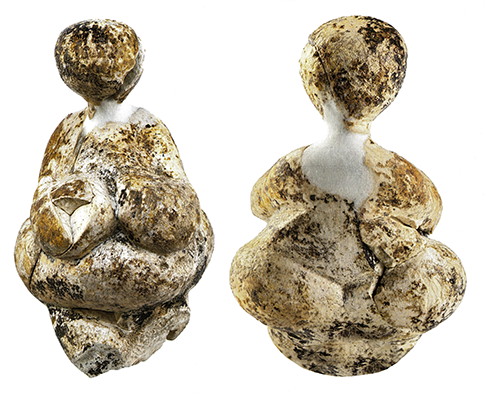
Detailed views of the front and back.
Photo: Merkel und Weiss (2017)
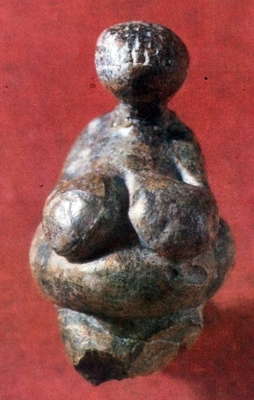
Frontal view of the Gagarino venus.
Photo: Abramov et al. (1984)
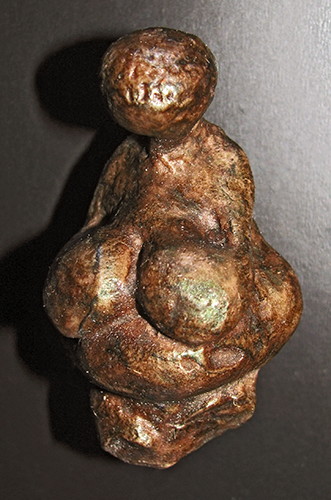
Gagarino Venus
Photo: Don Hitchcock 2008
Source: Facsimile at the Venusium, a museum at Willendorf in Austria.
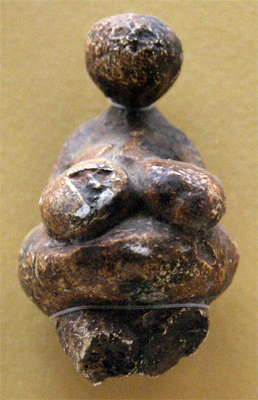
Gagarino site, Lipetsk region.
20 000 - 22 000 BP
Photo: Facsimile, Vladimir Gorodnjanski, 2011
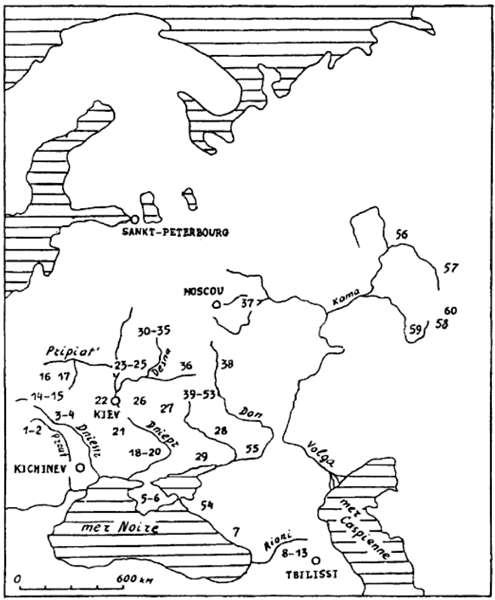
Distribution of mobile art in Eastern Europe.
1 Staryé Duruitory, 2 Brynzeny, 3 Kosseoutzy, 4 Klimaoutzy, 5 Suren' 1, 6 Chan-Koba, 7 Apiantcha, 8 grotte d'Uvarov, 9 Sakagia, 10 Sagvardgilé, 11 Gvardgilas-Kldé, 12 Devis-Khvreli, 13 Taro-Kldé, 14 Molodova V, 15 Lissitchniki, 16 Lipa VI, 17 Klinetz, 18 Ossokorovka, 19 Dubovaya Balka, 20 Kaïstrovaya Balka, 21 Mejiritch (Mezhirich), 22 Kievo-Kirillovskaya, 23 Mézine (Mizyn), 24 Novgorod Severskyi, 25 Puchkari I, 26 Dobranitchevka, 27 Gontzy, 28, Rogalik, 29 Amvrossievka, 30 Eliseevitchi I, 31 Eliseevitchi II, 32 Yudinovo, 33 Khoylevo II, 34 Timonovka, 35 Suponevo, 36 Avdeevo, 37 Sungir', 38 Gagarino, 39 Kostienki 19, 40 Kostienki 21, 41 Kostienki 13, 42 Kostienki 1, 43 Kostienki 14, 44 Kostienki 12, 45 Kostienki 17, 46 Kostienki 2, 47 Kostienki 11, 48 Kostienki 4, 49 Kostienki 15, 50 Kostienki 9, 51 Kostienki 8, 52 Borchtchevo 1, 53 Borchtchevo 2, 54 Ilskaya, 55 Murakovka, 56 Ostrovskaya, 57 Bez'imyannyi, 58 Smelobskaya, 59 Kapova, 60 Ignatievskaya.
Photo: Abramova (1995)
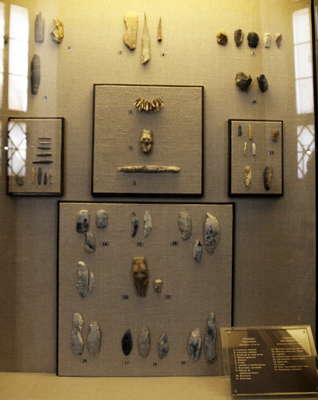
Стоянка Гагарино ( Липецкая область) - Gagarino Site (Lipetsk Region)
1. Статуэтка женская - female statuette
2. Статуэтка двойная - double statuette
3. Подвески из зубов песца - necklace of polar fox teeth
4. Шилья – проколки - bodkin - awl
5. Лощило - burnisher
6. Резцы - cutters
7. Скребки и сребки-резцы - scrapers and scraper - knives
8. Пластины с ретушью - blades with retouch
9. Орудия на микроплаcтинках - tools on blades
10. Нуклеусы - tool cores
11. Пластины - blades
Стоянка Костенки 1 ( Воронежская область) - Kostenki Site (Voronezh Region)
12. женская статуэтка. Копия - female statuette, copy
13. обломок статуэтки. Копия - fragment of statuette, copy
14. Скрeбки - scrapers
15. Наконечники с боковой выемкой - points with a tang for hafting
16. Листовидные наконечники - leaf-shaped points
17. Проколка - awl
18. Резцы - knives
19. Нож костёнковского типа - knife of Kostenki type
19. Пластины с ретушью - blades with retouch
Photo: Vladimir Gorodnjanski, 2007
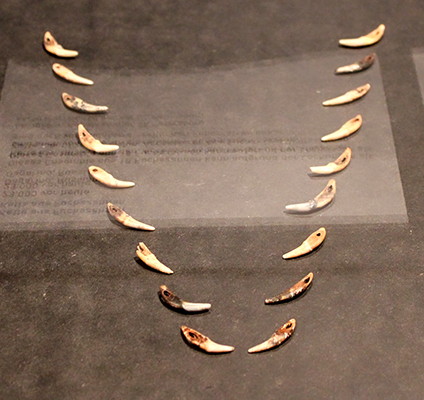
Fox teeth, Gagarino, 23 000 BP.
This group of 18 fox teeth can be identified as a chain from the perforations. Jewellery from fox and wolf teeth are also known from other ice age sites.
Photo: Ralph Frenken
Source: Original, exhibited at the Archeological Museum Hamburg (Ice Age - The Art of the Mammoth Hunters from 18 October 2016 to 14 May 2017)
On loan from the Hermitage Museum, Saint Petersburg, Russia.
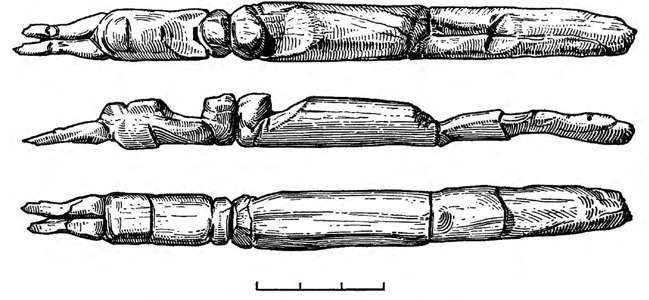
Double statuette of Gagarino, 148 mm x 52 mm x 12 mm.
The unfinished nature of Palaeolithic statuettes is a widespread phenomenon. It is probable that completion of the double statuette of Gagarino was abandoned after a fracture developed during manufacture.
It is fascinating to conjecture whether there is some relationship with the double burial at Sunghir, although since it is at least 500 km distant, this is just conjecture at this point.
Photo: Tarassov (1971)

Double statuette of Gagarino, with the arrow pointing to the place it was discovered in the dig.
Photo: Tarassov (1971)
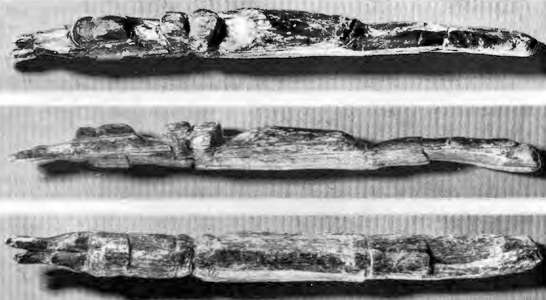
Double statuette of Gagarino.
Photo: M. G. Agaronian, Tarassov (1971)
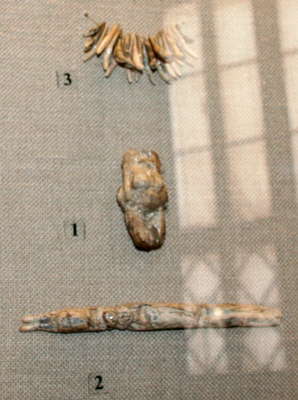
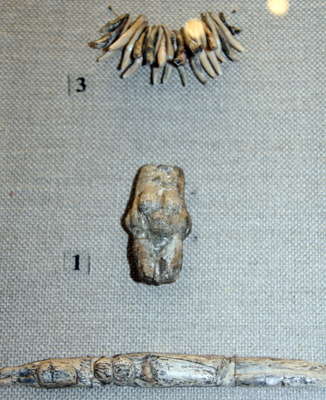
Gagarino artefacts:
1. Статуэтка женская - female statuette, facsimile.
2. Статуэтка двойная - double statuette, facsimile.
3. Подвески из зубов песца - necklace of polar fox teeth.
Photo: Vladimir Gorodnjanski, 2007
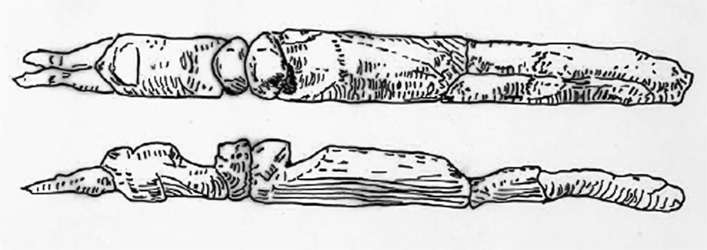
Gagarino Double Venus, the object shown as a facsimile at the foot of the photo above.
This has been interpreted as purposeful, similar to the way that the child burials at Sunghir were head to head.
(Another possible reason for this juxtaposition is that it was a temporary, convenient connection, and that the sculpture was incomplete. It was perhaps going to be two venuses, to be separated when almost finished, and left attached in the meantime to make carving easier. Militating against this viewpoint is that not much space was left to complete the tops of the heads in a pleasing rounded manner - Don )
Photo: Facsimiles, http://www.scribd.com/doc/76236202/3/BCE-Gagarino-Ukraine

The so-called 'double statuette' from Gagarino in Russia, which is in fact two unfinished statuettes in the course of being sculpted on a single ivory rod.
Both top and bottom figures show the same angled chest shelf that one sees on La Fillette. (Photo R. White).
Photo and text: White (2006)
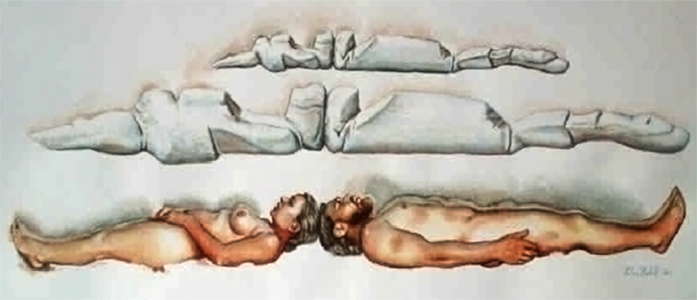
The Gagarino Double Venus, as interpreted by the talented artist Libor Balák.
Artist: Illustration © Libor Balák
Photo: http://www.scribd.com/doc/29170327/Body-Mirroring-at-Burials
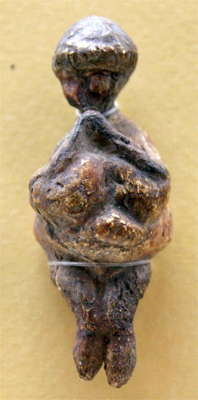
Gagarino site, Lipetsk region.
20 000 - 22 000 BP
This statuette is of particular interest, because of the unique pose: arms on the chest and hands raised to the face in a 'prayer' gesture.
Photo: Facsimile, Vladimir Gorodnjanski, 2011
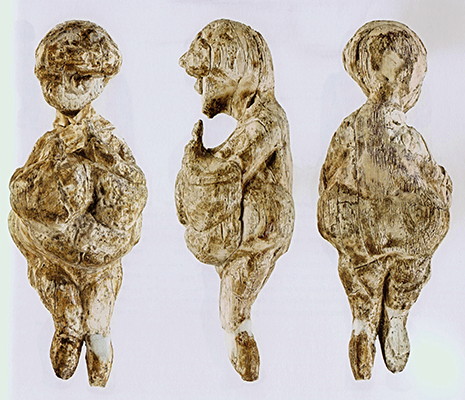
This is a detailed view of the 'prayer' venus from Gagarino from several sides.
Photo: Merkel und Weiss (2017)
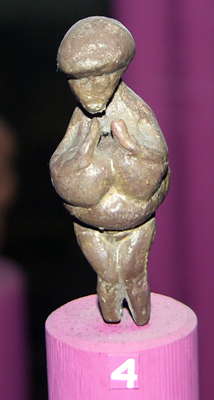
Gagarino site, Lipetsk region.
20 000 - 22 000 BP
Another facsimile of the 'praying' venus.
Photo: Michael Hess
Source: Senckenberg Museum in Frankfurt (Main)
 Statuette féminine de Gagarino, vue de profil. Collection MAE. Photo L.
Iakovleva.
Statuette féminine de Gagarino, vue de profil. Collection MAE. Photo L.
Iakovleva.
Venus from Gagarino, in profile view.
Photo and French text: "les mammouths - Dossiers
Archéologie - n° 291 - Mars 2004"
Photograph L Iakovleva.
My thanks to Anya for access to this resource.
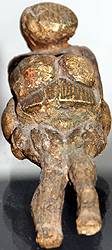
This is a fascinating venus figure, a front view of the venus shown in profile above. It has what appears to be an item of clothing or decoration below the breasts, the functionality of which is unclear.
Photo: Vladimir Gorodnjanski, 2006
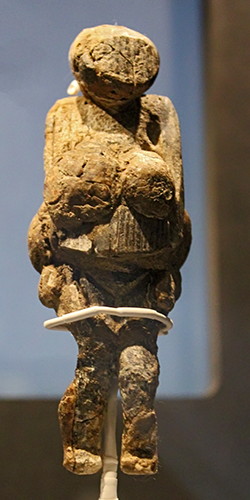
Venus, Gagarino
Photo: Ralph Frenken
Source: Original, exhibited at the Archeological Museum Hamburg (Ice Age - The Art of the Mammoth Hunters from 18 October 2016 to 14 May 2017)
On loan from the Hermitage Museum, Saint Petersburg, Russia.
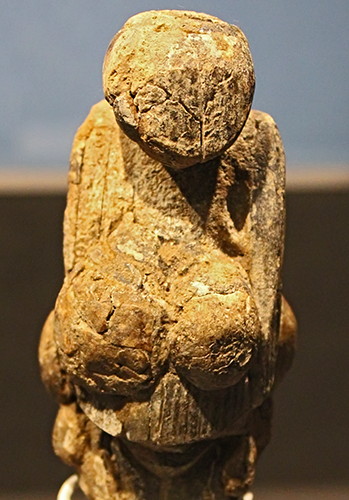
Venus, Gagarino
Photo: Ralph Frenken
Source: Original, exhibited at the Archeological Museum Hamburg (Ice Age - The Art of the Mammoth Hunters from 18 October 2016 to 14 May 2017)
On loan from the Hermitage Museum, Saint Petersburg, Russia.
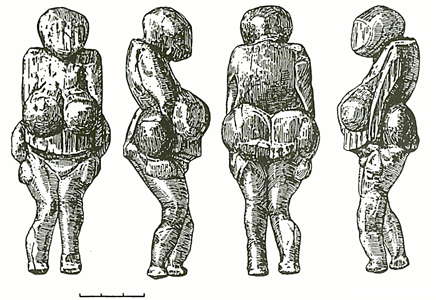
The Venus above, front, back, and profiles.
Photo: Abramova (1995)

Detailed version, in colour, of the above.
Photo: Merkel und Weiss (2017)
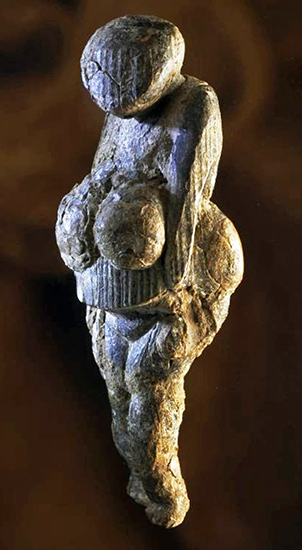
This is a photo which gives a good view of the 'apron' and the repeat of this rippled surface on the face and arms.
Photo: Martin Frouz
Source: Svoboda (2017)
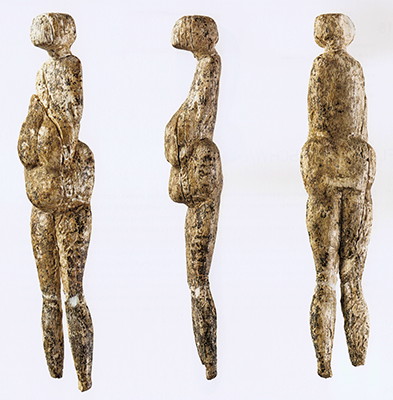
This is a good and detailed image of the original of a figurine from Gagarino known as 1927c.
I think of this as the 'tall' Gagarino venus. This venus, with relatively thin legs, is plump at the abdomen and breasts, as if carved from life.
It is often misidentified as being from Mal'ta.
White (2007) calls it Gagarino Statuette 1927c.
Photo: Merkel und Weiss (2017)
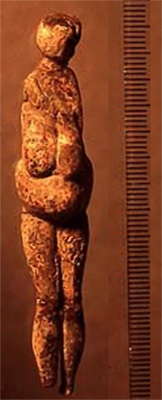
Figurine 1927c, Gagarino.
Length: 7.15 cm
Diameter: 1.35 cm
I think this is the original, since it was taken by Randall White.
Photo: White (2007)
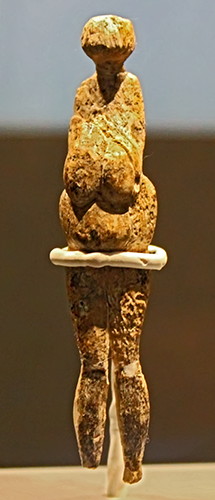
Venus 1927c, Gagarino
Photo: Ralph Frenken
Source: Original, exhibited at the Archeological Museum Hamburg (Ice Age - The Art of the Mammoth Hunters from 18 October 2016 to 14 May 2017)
On loan from the Hermitage Museum, Saint Petersburg, Russia.
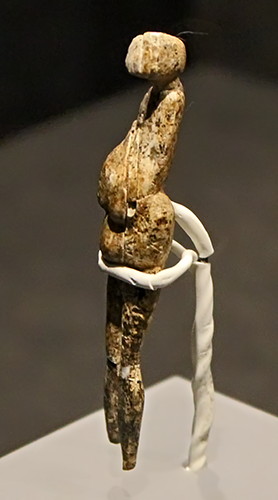
Venus 1927c, Gagarino
Photo: Ralph Frenken
Source: Original, exhibited at the Archeological Museum Hamburg (Ice Age - The Art of the Mammoth Hunters from 18 October 2016 to 14 May 2017)
On loan from the Hermitage Museum, Saint Petersburg, Russia.



Figurine 1927c, Gagarino.
This appears to be a facsimile.
Photo: http://www.nihilum.republika.pl/W_Gagarino_02.htm
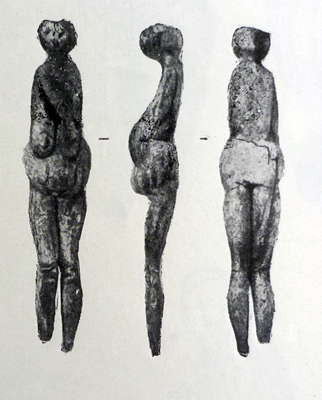
Figurine 1927c, Gagarino.
Identified as number 3 by Abramova (1962b)
Note that these images appear to have been poorly 'cut out' from the original photos.
Photo: Abramova (1962b)

Note the close similarity of the 'tall' Gagarino lvenus to the Avdeevo venus shown here.
It could easily have been done by the same artist.
This figurine No. 5 (Old Avdeevo Avd-St 49) was found in fragments in the wall of a pit. It is 160 mm long, 30 mm wide, and only 11 mm thick. The buttocks and the lower portion of the legs are missing. The figurine is completely smoothed and finished.
It is very flat and all volumes are rendered in low relief. The upper torso is very elongated. A rounded head with a protruding facial area is disproportionately small. Narrow drooping shoulders and arms are shown only by a cut in both shoulders. Sagging, teardrop-shaped breasts descend to a rounded, flat abdomen, which turns into the pubic triangle.
The maximum width of the figurine occurs at the upper portion of the pelvis. Long slender legs are rendered separately above the knee. The outer leg contour is X-shaped. The feet were probably rendered separately. The slope of the back is slightly convex. The figurine represents a tall, slender, mature, but not pregnant woman.
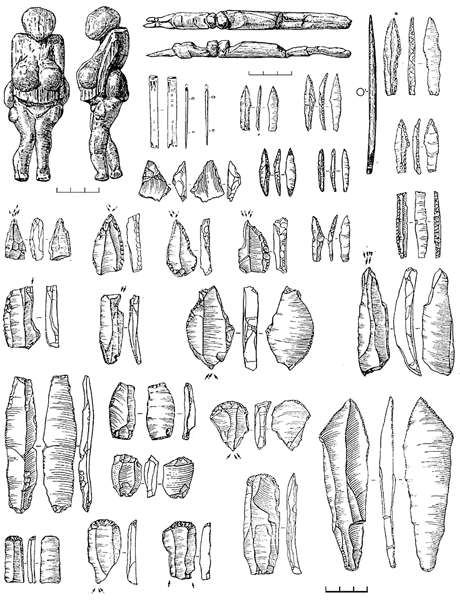
Gagarino differs from typical Kostienki assemblages by:
* The composition of different tools
* The structure of the living space
* Stylistic details relating to female statuettes
* Bone fasteners and a biconical perforation technique which is unknown to Kostienki 1 (I) and Avdeevo.
The most specific features of the Gagarino lithic assemblage are that the proportions of tanged points are different from that of Avdeevo and Kostienki 1, there are particular forms of tanged points and Kostienki knives.
A series of eight dates were obtained, of which two are most likely: 21 600 ± 140 BP and 21 800 ± 300 BP.
Photo and text: Sinitsyn (2007)
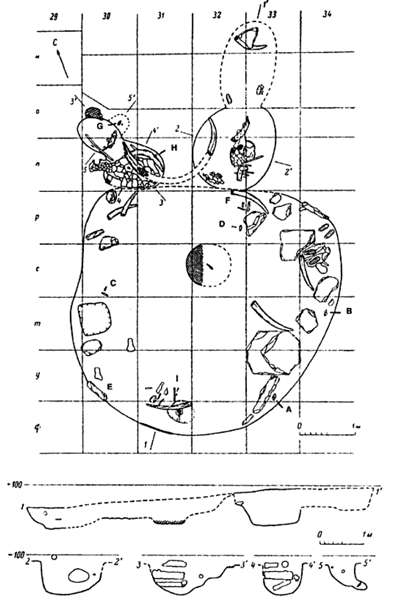
Plan and profile of the habitation at Gagarino.
Disposition of the statuettes:
A. cat. 38, 1
B. cat. 38, 2
C. cat. 38, 3
D. cat. 38, 4
E. cat. 38, 5
F. cat. 38, 6
G. cat. 38, 9
H. cat. 38, 11
I. cat. 38, 14
Photo: Abramova (1995) after Tarassov (1979), fig. 27.

Zoya A. Abramova.
Photo: Abramova (1995)
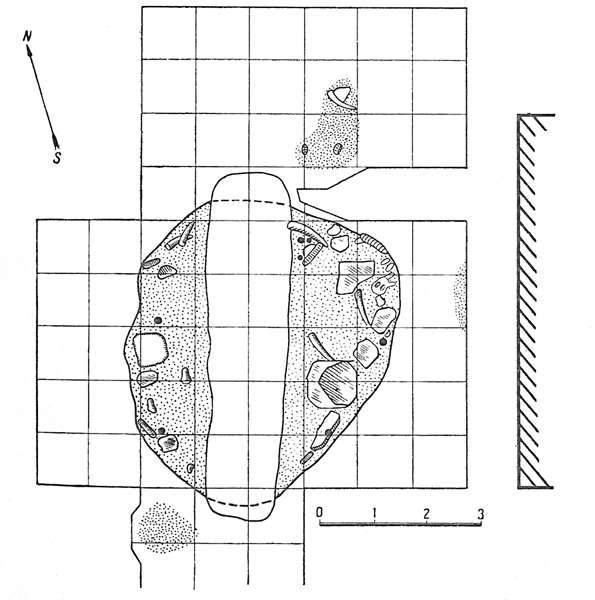
Plan of Gagarino-on-Don.
Black dots represent positions of Venus figures.
This diagram shows clearly the trench cut by the peasants who found the site while digging a silo trench, a technique for storing fermented feed known as silage.
Photo: Zamjatnin (1934)
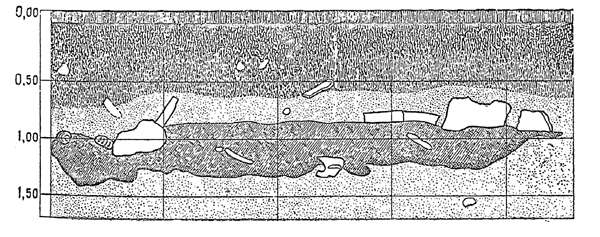
Profile of Gagarino-on-Don.
Photo: Zamjatnin (1934)
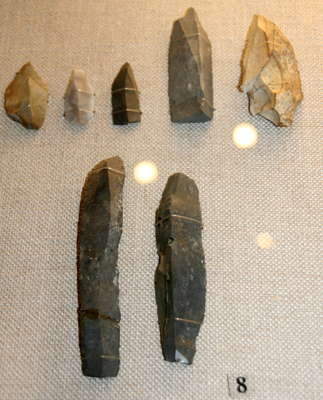
Пластины с ретушью
Gagarino blades with retouch. High skill and good stone is required for blades of this length and width.
Photo: Vladimir Gorodnjanski 2008
Source: Voronezh Museum.
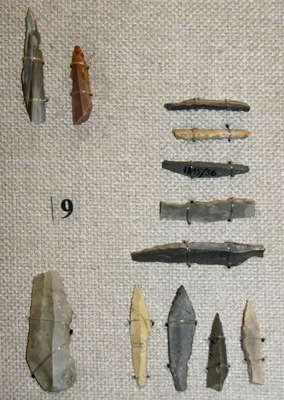
Орудия на микроплаcтинках
Gagarino tools on blades. Note especially the shouldered points in the bottom row, knapped so that they can be hafted to form a knife, as at Kostenki, which has a very similar toolkit.
Photo: Vladimir Gorodnjanski 2008
Source: Voronezh Museum.
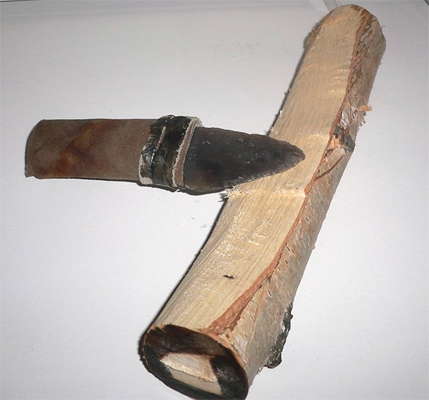
This shows the classic shouldered point, or point with tang, with a handle attached, as used at Kostenki. The tools are razor sharp, and very effective.
This recreation shows the handle being made of leather wrapped around the tang. Other methods would include the use of bone or antler as a handle.
Photo: http://baida.su/2010/07/progulka-na-20-000-let-nazad/
Source: Kostenki Museum.
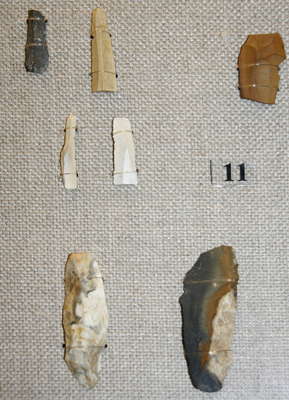
Gagarino tools on blades.
Photo: Vladimir Gorodnjanski 2008
Source: Voronezh Museum.
References
- Abramov A., Anikovich M., Bader N., Boriskovsky P., Lubin V., Praslin N., Rogachev A., А. АБРАМОВА, М. В. АНИКОВИЧ, Н. О. БАДЕР, П. И. БОРИСКОВСКИЙ, В. П. ЛЮБИН, Н. Д. ПРАСЛОВ, А. Н. РОГАЧЕВ, 1984: Archaeology of the USSR. 1984, Nauka, Moscow, 1984
- Abramova Z., 1962: L'Art paléolithique sur le territoire de l'URSS. , Moscou-Léningrad: Académie des Sciences (en russe).
- Abramova Z., 1962b: Paleolitičeskoe iskusstvo na territorii SSSR, Moskva : Akad. Nauk SSSR, Inst. Archeologii, 1962 (probably the same book as above - Don )
- Abramova Z., 1995: L'Art paléolithique d'Europe orientale et de Sibérie, Grenoble: Jérôme Millon.
- Daifuku H., 1952: The pit house in the old world and in native north america, American Antiquity, Vol XVIII, No 1, July, 1952
- Merkel M., Weiss R., 2017: Eiszeiten: Die Kunst der Mammutjäger - Die Menschen des Nordlichts, von Museum für Völkerkunde (Herausgeber), Gebundene Ausgabe: 216 Seiten, ISBN-10: 3944193059, ISBN-13: 978-3944193052
- Svoboda J., 2017: Upper Paleolithic female figurines of Northern Eurasia, PETRKOVICE, The Dolní Věstonice Studies 15, Brno 2008, 193-223 December 2017, Project: origins of art
- Tarassov L., 1965: La Station paléolithique de Gagarino, Moscou-Leningrad: Materialii Issledovania, t. 131 (en russe).
- Tarassov L., 1971: La double statuette paléolithique de GagarinoQuärtar , 157-63.
- Tarassov L., 1979: Le site de Gagarino et sa place dans le Paléolithique de l'Europe, Leningrad: Académie des Sciences (en russe).
- Tarassov L., 1995: Les statuettes féminines de Gagarino, ERAUL, 74, ISSN 0773-2173. p. 239-247
- White R., 2006: The Women of Brassempouy: A Century of Research and Interpretation, Journal of Archaeological Method and Theory, Article, Dec 2006
- White R., 2007: Technological Observations On The "Double Statuette" From Gagarino, http://www.insticeagestudies.com/library/double-statuette-from-gagarino/ Dec 23, 2007
- Zamjatnin S., 1934: La station aurignacienne de Gagarino et les données nouvelles qu’elles fournit sur les rites magiques des chasseurs quaternaires., Les Éditions d’État, section social et économique, Moscou-Leningrad.